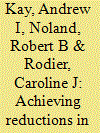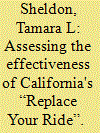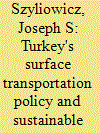|
|
|
Sort Order |
|
|
|
Items / Page
|
|
|
|
|
|
|
| Srl | Item |
| 1 |
ID:
132687


|
|
|
|
|
| Publication |
2014.
|
| Summary/Abstract |
It is well established that GHG emissions must be reduced 50 to 80% by 2050 in order to limit global temperature increase to 2 °C. Achieving reductions of this magnitude in the transportation sector is a challenge and requires a multitude of policies and technology options. The research presented here analyzes three scenarios: changes in the perceived price of travel, land use intensification, and increases in transit. Elasticity estimates are derived using an activity-based travel model for the state of California and broadly representative of the US. The VISION model is used to forecast changes in technology and fuel options that are currently forecast to occur in the US for the period 2000-2040, providing a life-cycle GHG forecast for the road transportation sector. Results suggest that aggressive policy action is required, especially pricing policies, but also more on the technology side, especially increases in the carbon efficiency of medium and heavy-duty vehicles.
|
|
|
|
|
|
|
|
|
|
|
|
|
|
|
|
| 2 |
ID:
134127


|
|
|
|
|
| Publication |
2014.
|
| Summary/Abstract |
This article examines the problems of integrating the Central Asian states into the transportation and communication sphere, as well as the factors influencing this process. It analyzes the trends in building alternative transportation corridors and reveals their development advantages and prospects. It presents a comparative year-by-year analysis of the changes in the interdependence of the transportation sectors of the region's states.
|
|
|
|
|
|
|
|
|
|
|
|
|
|
|
|
| 3 |
ID:
166966


|
|
|
|
|
| Summary/Abstract |
We analyze the effectiveness of California's “Replace Your Ride” policy, a pilot program that gives subsidies to lower income households in the greater Los Angeles area to retire older vehicles and replace them with newer, cleaner vehicles. Using a differences in differences strategy to compare changes in new vehicle purchase probabilities between income eligible and ineligible households before and after the implementation of the program, we find that in 2015, upwards of 44% of plug-in electric vehicle and 78% of hybrid vehicle purchases under the program were additional.
|
|
|
|
|
|
|
|
|
|
|
|
|
|
|
|
| 4 |
ID:
162916


|
|
|
|
|
| Summary/Abstract |
Regional air pollution is strongly impacted by transportation emissions. Policy mechanisms to reduce emissions are required to reach environmental quality goals. Projecting the drivers (e.g., technical, economic, societal, regulatory) that will impact future emissions is challenging, and assessing regional air quality (AQ) is complicated by the need for detailed modeling tools and data inputs to simulate chemistry and transport of pollutants. This work assesses the contribution of emissions from transportation sources to ground-level concentrations of ozone and fine particulate matter via two methods. First, impacts are quantified for three U.S. regions including California using output from an economic optimization model to grow a base year emissions inventory to 2055. Second, impacts are considered for California using state-level projections with an updated emissions inventory and modeling suite in 2035. For both, advanced AQ models are used, showing that the impacts of light duty vehicles are moderate, reflecting shifts to more efficient and lower emitting technologies. In contrast, heavy duty vehicles, ships, and off-road equipment are associated with important ozone and PM2.5 burdens. Emissions from petroleum fuel production and distribution activities also have notable impacts on ozone and PM2.5. These transportation sub-sectors should be the focus of future emissions reduction policies.
|
|
|
|
|
|
|
|
|
|
|
|
|
|
|
|
| 5 |
ID:
088279


|
|
|
|
|
| Publication |
2009.
|
| Summary/Abstract |
The US transportation sector is a major contributor to global greenhouse gas (GHG) emissions. As such, policymakers and stakeholder groups have proposed a number of policy instruments aimed at reducing these emissions. In order to fully evaluate the effectiveness of these policies, policymakers must consider both the direct responses associated with policy actions, and the indirect responses that occur through complex relationships within socioeconomic systems. In cases where multiple policy instruments are employed, these indirect effects create policy interactions that are either complementary or competing; policymakers need to understand these interactions in order to leverage policy synergies and manage policy conflicts. Analysis of these indirect effects is particularly difficult in the transportation sector, where system boundaries are uncertain and feedback among systems components can be complicated. This paper begins to address this problem by applying systems dynamics tools (in particular causal loop diagrams) to help identify and understand the role of feedback effects on transportation-related GHG reduction policies. Policymakers can use this framework to qualitatively explore the impacts of various policy instruments, as well as identify important relationships that can be later included in quantitative modeling approaches.
|
|
|
|
|
|
|
|
|
|
|
|
|
|
|
|
| 6 |
ID:
166333


|
|
|
|
|
| Summary/Abstract |
Vehicle automation is coming, but environmental and energy imperatives are NOT what’s motivating it. In fact, its energy and environmental outcomes are deeply uncertain. The promise of autonomous vehicles (AVs) is greater safety and mobility. The question is: How do we achieve that promise while reducing greenhouse gas (GHG) emissions and saving energy?
|
|
|
|
|
|
|
|
|
|
|
|
|
|
|
|
| 7 |
ID:
092796


|
|
|
|
|
| Publication |
2009.
|
| Summary/Abstract |
Railway freight transportation presents a degree of complexity which frequently makes impossible to model it with sufficient precision. Currently, energetic and environmental impacts of freight transportation are usually modelled following average data, which do not reflect the characteristics of specific lines. These models allow qualitative approximations which may be used as criteria for designing high-level transportation policies: road-train modal shift, regional energetic planning or environmental policies.
This paper proposes a methodology for estimating railway consumption associated to a specific railway line which yields a new degree of precision. It is based on estimating different contributions to railway consumption by a collection of factors, mobility, operation, or infrastructure-related. This procedure also allows applying the methodology for designing transportation policies in detail: evaluating impact of modal shift, consumption and pollutant emissions on a specific line, as well as the effect of building tunnels, reducing slopes, improving traffic control, etc.
A comparison of the estimations given by the conventional approach and the proposed methodology is offered, as well as further comments on the results.
|
|
|
|
|
|
|
|
|
|
|
|
|
|
|
|
| 8 |
ID:
136212


|
|
|
|
|
| Summary/Abstract |
Many cities worldwide have considered vehicle restriction policies to curb proliferating problems related to traffic and pollution. At the beginning of 2011, Beijing became the first city to allocate vehicle license plates using a lottery. We provide a background on Beijing׳s lottery and analyze its short-term effects. We find that growth in new vehicle registrations has been sharply curtailed. However, this policy may not reduce fuel consumption as much as expected.
|
|
|
|
|
|
|
|
|
|
|
|
|
|
|
|
| 9 |
ID:
051767


|
|
|
|
|
|
|
|